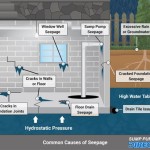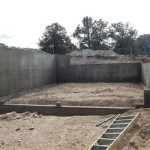How To Insulate A Basement Wall
Insulating your basement wall is one of the most important steps you can take to make your home more energy-efficient and comfortable. By keeping the cold air out and the warm air in, you can save money on your energy bills and create a more enjoyable living space. Here are the essential steps on how to insulate a basement wall:
1. Prepare the Wall
Before you begin insulating, you need to prepare the wall by removing any dirt, debris, or old insulation. You should also check for any cracks or holes and seal them with caulk or expanding foam. If there is any mold or mildew on the wall, you will need to remove it completely. A wire brush and household bleach should eliminate any mold/mildew issues.
2. Choose the Right Insulation
There are several different types of insulation that you can use for your basement wall, including fiberglass batts, cellulose, and spray foam. Fiberglass batts are the most common type of insulation, and they are relatively inexpensive. Cellulose is a more eco-friendly option, and it is also more resistant to moisture. Spray foam is the most expensive type of insulation, but it is also the most effective.
3. Install the Insulation
Once you have chosen the right insulation, you can begin installing it. If you are using fiberglass batts, you will need to cut them to fit the space between the studs. You can then insert the batts into place and secure them with staples or nails. If you are using cellulose, you will need to pour it into the space between the studs. You can then tamp it down to compact it. If you are using spray foam, you will need to apply it to the wall using a spray gun. You will need to wear a mask and eye protection when applying spray foam.
4. Cover the Insulation
Once you have installed the insulation, you will need to cover it with a vapor barrier. A vapor barrier will help to prevent moisture from entering the insulation. You can use plastic sheeting or a commercial vapor barrier product. You will need to seal the seams of the vapor barrier with tape.
5. Finish the Wall
Once you have covered the insulation with a vapor barrier, you can finish the wall. You can drywall the wall, panel it, or paint it. You can also install molding or trim to give the wall a more finished look.
Benefits of Insulating Your Basement Wall
There are many benefits to insulating your basement wall. Some of the benefits of insulating your basement wall include:
- Reduced energy bills
- Increased comfort
- Reduced moisture problems
- Improved air quality
- Increased home value

Three Ways To Insulate A Basement Wall Fine Homebuilding

How To Insulate A Basement Wall Greenbuildingadvisor

How To Insulate Your Basement Like A Pro

How To Insulate Your Basement S Concrete Walls The Seattle Times

Healthy Basement Insulation Systems Quality Built Basements Llc

Doe Building Foundations Section 2 1 Insulation

Insulating Basement Walls With Fiberglass Batting Semigloss Design

How To Insulate Basement Walls True Value

Inorganic Basement Wall Panels In Stamford Norwalk West Hartford By Expert Contractors To Beautiful Insulated

Insulation For A Conditioned Basement Greenbuildingadvisor
See Also








